HMG7230: Yemen Food Security and Resilience Analysis Report
VerifiedAdded on 2022/10/01
|17
|4227
|457
Report
AI Summary
This report provides a comprehensive analysis of the food system in Yemen, a country facing escalating food insecurity due to conflict and limited resources. It examines food utilization, consumption, access (internal and external), and availability, highlighting the impact of the ongoing conflict and reliance on imports. The analysis delves into the supporting resources, services, and policies, while also assessing the vulnerabilities of the food system to shocks like climate change. The report identifies risks and proposes recommendations to enhance resilience. Finally, it evaluates relevant food policies, such as the 2020-2021 Yemen Country Engagement Note and the Yemen Famine Prevention Plan, to determine their effectiveness in supporting the recommended strategies. The study underscores the urgent need for interventions to improve food security in Yemen.
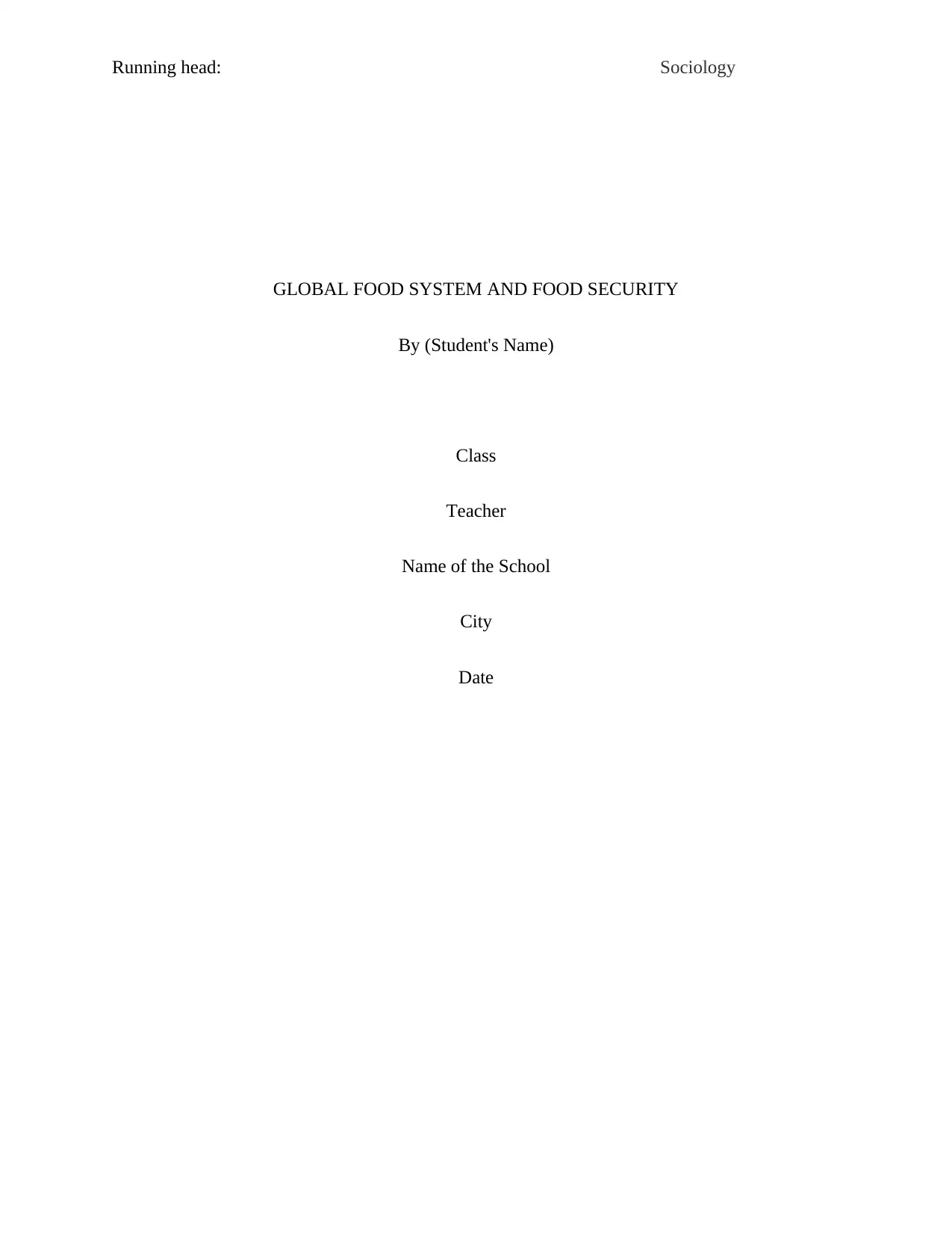
Running head: Sociology
GLOBAL FOOD SYSTEM AND FOOD SECURITY
By (Student's Name)
Class
Teacher
Name of the School
City
Date
GLOBAL FOOD SYSTEM AND FOOD SECURITY
By (Student's Name)
Class
Teacher
Name of the School
City
Date
Paraphrase This Document
Need a fresh take? Get an instant paraphrase of this document with our AI Paraphraser
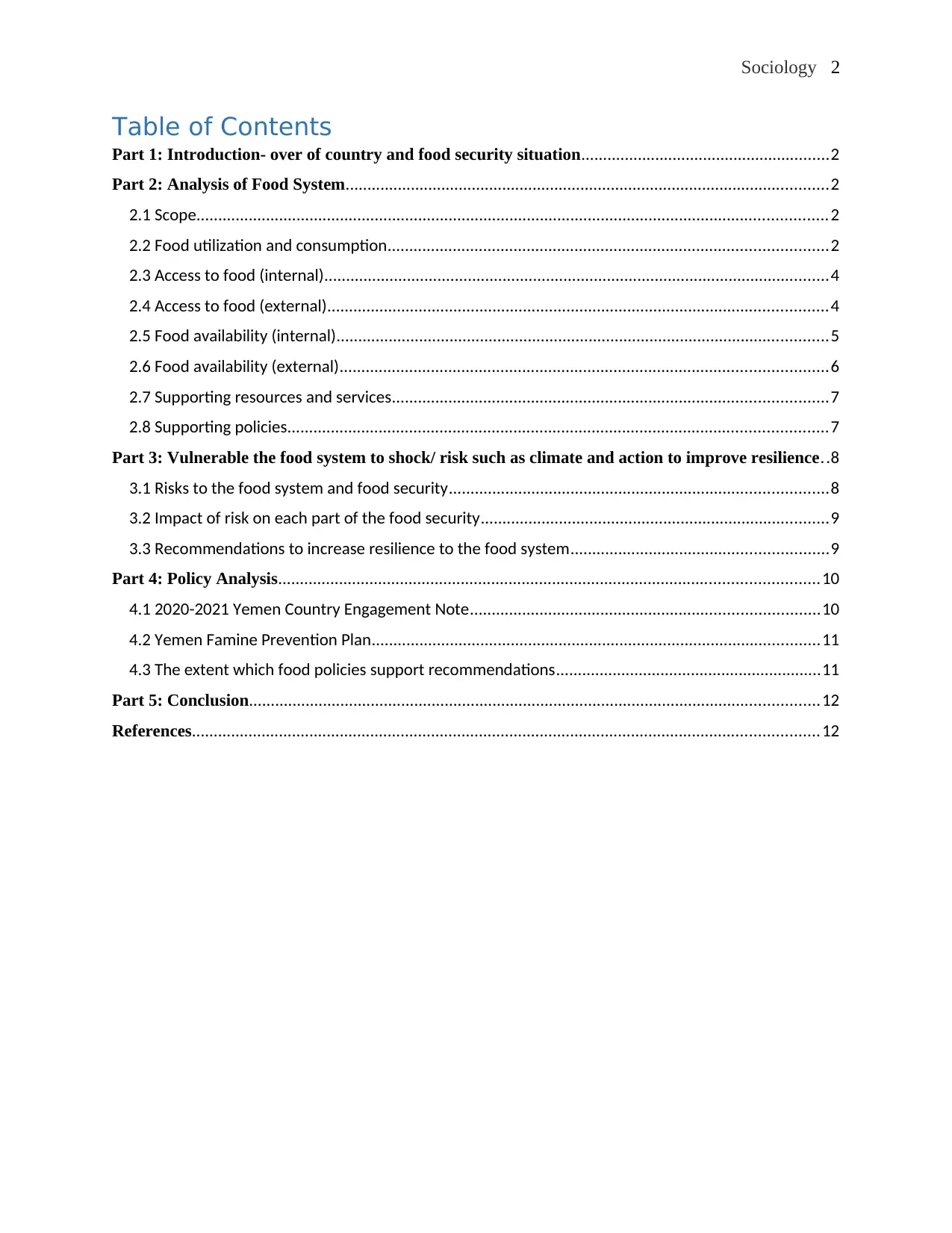
Sociology 2
Table of Contents
Part 1: Introduction- over of country and food security situation.........................................................2
Part 2: Analysis of Food System...............................................................................................................2
2.1 Scope.................................................................................................................................................2
2.2 Food utilization and consumption.....................................................................................................2
2.3 Access to food (internal)....................................................................................................................4
2.4 Access to food (external)...................................................................................................................4
2.5 Food availability (internal).................................................................................................................5
2.6 Food availability (external)................................................................................................................6
2.7 Supporting resources and services....................................................................................................7
2.8 Supporting policies............................................................................................................................7
Part 3: Vulnerable the food system to shock/ risk such as climate and action to improve resilience..8
3.1 Risks to the food system and food security.......................................................................................8
3.2 Impact of risk on each part of the food security................................................................................9
3.3 Recommendations to increase resilience to the food system...........................................................9
Part 4: Policy Analysis............................................................................................................................10
4.1 2020-2021 Yemen Country Engagement Note................................................................................10
4.2 Yemen Famine Prevention Plan.......................................................................................................11
4.3 The extent which food policies support recommendations.............................................................11
Part 5: Conclusion...................................................................................................................................12
References................................................................................................................................................12
Table of Contents
Part 1: Introduction- over of country and food security situation.........................................................2
Part 2: Analysis of Food System...............................................................................................................2
2.1 Scope.................................................................................................................................................2
2.2 Food utilization and consumption.....................................................................................................2
2.3 Access to food (internal)....................................................................................................................4
2.4 Access to food (external)...................................................................................................................4
2.5 Food availability (internal).................................................................................................................5
2.6 Food availability (external)................................................................................................................6
2.7 Supporting resources and services....................................................................................................7
2.8 Supporting policies............................................................................................................................7
Part 3: Vulnerable the food system to shock/ risk such as climate and action to improve resilience..8
3.1 Risks to the food system and food security.......................................................................................8
3.2 Impact of risk on each part of the food security................................................................................9
3.3 Recommendations to increase resilience to the food system...........................................................9
Part 4: Policy Analysis............................................................................................................................10
4.1 2020-2021 Yemen Country Engagement Note................................................................................10
4.2 Yemen Famine Prevention Plan.......................................................................................................11
4.3 The extent which food policies support recommendations.............................................................11
Part 5: Conclusion...................................................................................................................................12
References................................................................................................................................................12
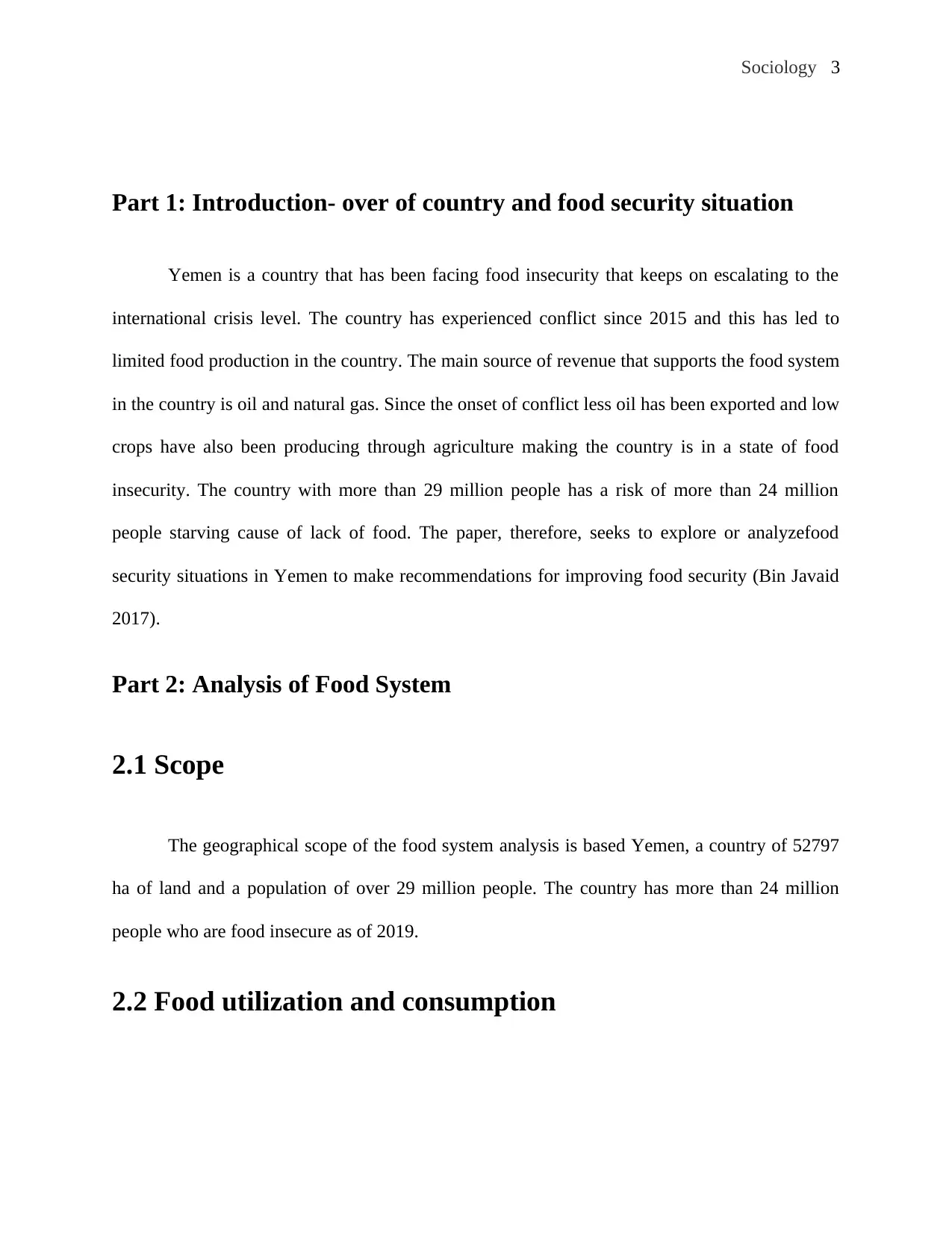
Sociology 3
Part 1: Introduction- over of country and food security situation
Yemen is a country that has been facing food insecurity that keeps on escalating to the
international crisis level. The country has experienced conflict since 2015 and this has led to
limited food production in the country. The main source of revenue that supports the food system
in the country is oil and natural gas. Since the onset of conflict less oil has been exported and low
crops have also been producing through agriculture making the country is in a state of food
insecurity. The country with more than 29 million people has a risk of more than 24 million
people starving cause of lack of food. The paper, therefore, seeks to explore or analyzefood
security situations in Yemen to make recommendations for improving food security (Bin Javaid
2017).
Part 2: Analysis of Food System
2.1 Scope
The geographical scope of the food system analysis is based Yemen, a country of 52797
ha of land and a population of over 29 million people. The country has more than 24 million
people who are food insecure as of 2019.
2.2 Food utilization and consumption
Part 1: Introduction- over of country and food security situation
Yemen is a country that has been facing food insecurity that keeps on escalating to the
international crisis level. The country has experienced conflict since 2015 and this has led to
limited food production in the country. The main source of revenue that supports the food system
in the country is oil and natural gas. Since the onset of conflict less oil has been exported and low
crops have also been producing through agriculture making the country is in a state of food
insecurity. The country with more than 29 million people has a risk of more than 24 million
people starving cause of lack of food. The paper, therefore, seeks to explore or analyzefood
security situations in Yemen to make recommendations for improving food security (Bin Javaid
2017).
Part 2: Analysis of Food System
2.1 Scope
The geographical scope of the food system analysis is based Yemen, a country of 52797
ha of land and a population of over 29 million people. The country has more than 24 million
people who are food insecure as of 2019.
2.2 Food utilization and consumption
⊘ This is a preview!⊘
Do you want full access?
Subscribe today to unlock all pages.

Trusted by 1+ million students worldwide
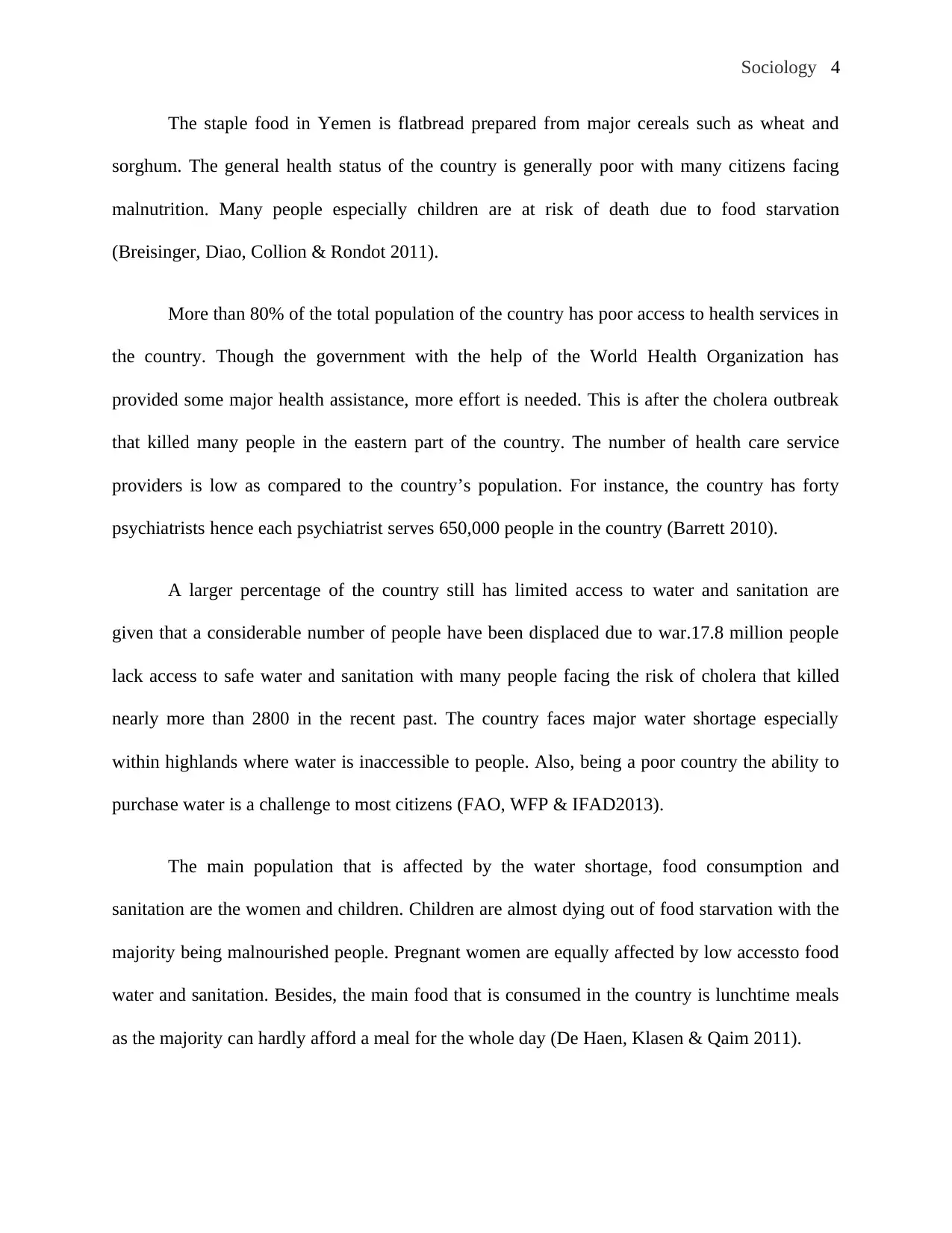
Sociology 4
The staple food in Yemen is flatbread prepared from major cereals such as wheat and
sorghum. The general health status of the country is generally poor with many citizens facing
malnutrition. Many people especially children are at risk of death due to food starvation
(Breisinger, Diao, Collion & Rondot 2011).
More than 80% of the total population of the country has poor access to health services in
the country. Though the government with the help of the World Health Organization has
provided some major health assistance, more effort is needed. This is after the cholera outbreak
that killed many people in the eastern part of the country. The number of health care service
providers is low as compared to the country’s population. For instance, the country has forty
psychiatrists hence each psychiatrist serves 650,000 people in the country (Barrett 2010).
A larger percentage of the country still has limited access to water and sanitation are
given that a considerable number of people have been displaced due to war.17.8 million people
lack access to safe water and sanitation with many people facing the risk of cholera that killed
nearly more than 2800 in the recent past. The country faces major water shortage especially
within highlands where water is inaccessible to people. Also, being a poor country the ability to
purchase water is a challenge to most citizens (FAO, WFP & IFAD2013).
The main population that is affected by the water shortage, food consumption and
sanitation are the women and children. Children are almost dying out of food starvation with the
majority being malnourished people. Pregnant women are equally affected by low accessto food
water and sanitation. Besides, the main food that is consumed in the country is lunchtime meals
as the majority can hardly afford a meal for the whole day (De Haen, Klasen & Qaim 2011).
The staple food in Yemen is flatbread prepared from major cereals such as wheat and
sorghum. The general health status of the country is generally poor with many citizens facing
malnutrition. Many people especially children are at risk of death due to food starvation
(Breisinger, Diao, Collion & Rondot 2011).
More than 80% of the total population of the country has poor access to health services in
the country. Though the government with the help of the World Health Organization has
provided some major health assistance, more effort is needed. This is after the cholera outbreak
that killed many people in the eastern part of the country. The number of health care service
providers is low as compared to the country’s population. For instance, the country has forty
psychiatrists hence each psychiatrist serves 650,000 people in the country (Barrett 2010).
A larger percentage of the country still has limited access to water and sanitation are
given that a considerable number of people have been displaced due to war.17.8 million people
lack access to safe water and sanitation with many people facing the risk of cholera that killed
nearly more than 2800 in the recent past. The country faces major water shortage especially
within highlands where water is inaccessible to people. Also, being a poor country the ability to
purchase water is a challenge to most citizens (FAO, WFP & IFAD2013).
The main population that is affected by the water shortage, food consumption and
sanitation are the women and children. Children are almost dying out of food starvation with the
majority being malnourished people. Pregnant women are equally affected by low accessto food
water and sanitation. Besides, the main food that is consumed in the country is lunchtime meals
as the majority can hardly afford a meal for the whole day (De Haen, Klasen & Qaim 2011).
Paraphrase This Document
Need a fresh take? Get an instant paraphrase of this document with our AI Paraphraser
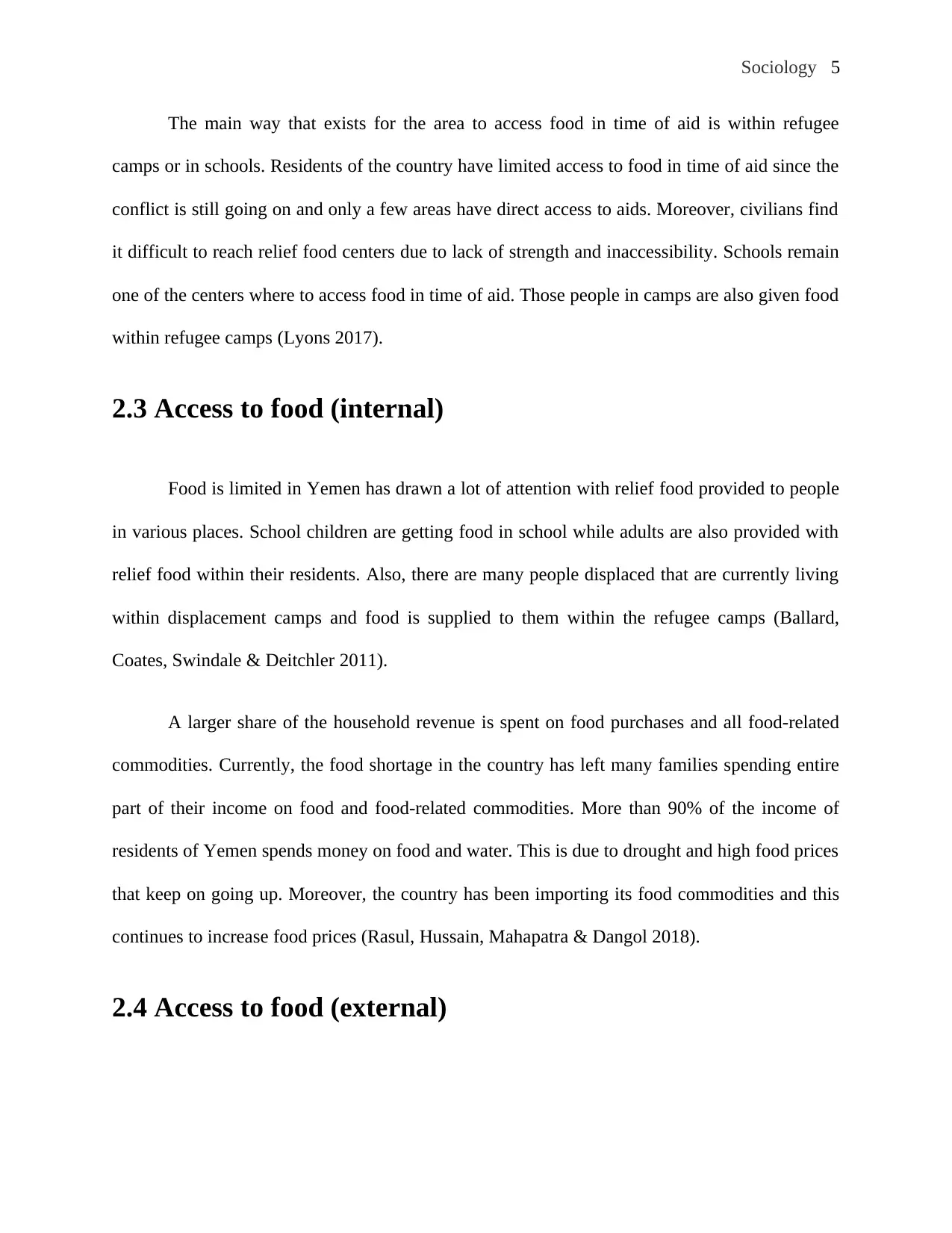
Sociology 5
The main way that exists for the area to access food in time of aid is within refugee
camps or in schools. Residents of the country have limited access to food in time of aid since the
conflict is still going on and only a few areas have direct access to aids. Moreover, civilians find
it difficult to reach relief food centers due to lack of strength and inaccessibility. Schools remain
one of the centers where to access food in time of aid. Those people in camps are also given food
within refugee camps (Lyons 2017).
2.3 Access to food (internal)
Food is limited in Yemen has drawn a lot of attention with relief food provided to people
in various places. School children are getting food in school while adults are also provided with
relief food within their residents. Also, there are many people displaced that are currently living
within displacement camps and food is supplied to them within the refugee camps (Ballard,
Coates, Swindale & Deitchler 2011).
A larger share of the household revenue is spent on food purchases and all food-related
commodities. Currently, the food shortage in the country has left many families spending entire
part of their income on food and food-related commodities. More than 90% of the income of
residents of Yemen spends money on food and water. This is due to drought and high food prices
that keep on going up. Moreover, the country has been importing its food commodities and this
continues to increase food prices (Rasul, Hussain, Mahapatra & Dangol 2018).
2.4 Access to food (external)
The main way that exists for the area to access food in time of aid is within refugee
camps or in schools. Residents of the country have limited access to food in time of aid since the
conflict is still going on and only a few areas have direct access to aids. Moreover, civilians find
it difficult to reach relief food centers due to lack of strength and inaccessibility. Schools remain
one of the centers where to access food in time of aid. Those people in camps are also given food
within refugee camps (Lyons 2017).
2.3 Access to food (internal)
Food is limited in Yemen has drawn a lot of attention with relief food provided to people
in various places. School children are getting food in school while adults are also provided with
relief food within their residents. Also, there are many people displaced that are currently living
within displacement camps and food is supplied to them within the refugee camps (Ballard,
Coates, Swindale & Deitchler 2011).
A larger share of the household revenue is spent on food purchases and all food-related
commodities. Currently, the food shortage in the country has left many families spending entire
part of their income on food and food-related commodities. More than 90% of the income of
residents of Yemen spends money on food and water. This is due to drought and high food prices
that keep on going up. Moreover, the country has been importing its food commodities and this
continues to increase food prices (Rasul, Hussain, Mahapatra & Dangol 2018).
2.4 Access to food (external)
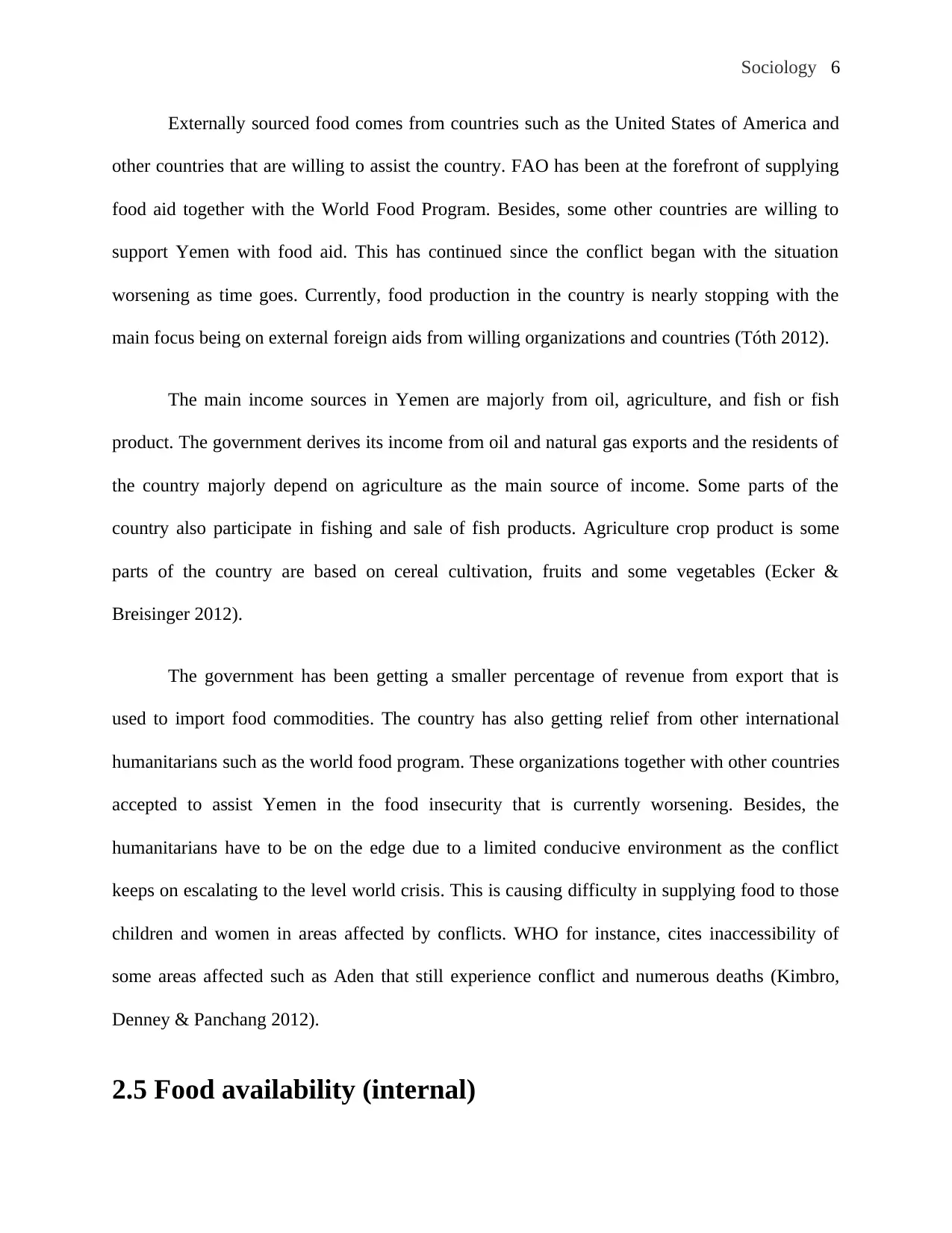
Sociology 6
Externally sourced food comes from countries such as the United States of America and
other countries that are willing to assist the country. FAO has been at the forefront of supplying
food aid together with the World Food Program. Besides, some other countries are willing to
support Yemen with food aid. This has continued since the conflict began with the situation
worsening as time goes. Currently, food production in the country is nearly stopping with the
main focus being on external foreign aids from willing organizations and countries (Tóth 2012).
The main income sources in Yemen are majorly from oil, agriculture, and fish or fish
product. The government derives its income from oil and natural gas exports and the residents of
the country majorly depend on agriculture as the main source of income. Some parts of the
country also participate in fishing and sale of fish products. Agriculture crop product is some
parts of the country are based on cereal cultivation, fruits and some vegetables (Ecker &
Breisinger 2012).
The government has been getting a smaller percentage of revenue from export that is
used to import food commodities. The country has also getting relief from other international
humanitarians such as the world food program. These organizations together with other countries
accepted to assist Yemen in the food insecurity that is currently worsening. Besides, the
humanitarians have to be on the edge due to a limited conducive environment as the conflict
keeps on escalating to the level world crisis. This is causing difficulty in supplying food to those
children and women in areas affected by conflicts. WHO for instance, cites inaccessibility of
some areas affected such as Aden that still experience conflict and numerous deaths (Kimbro,
Denney & Panchang 2012).
2.5 Food availability (internal)
Externally sourced food comes from countries such as the United States of America and
other countries that are willing to assist the country. FAO has been at the forefront of supplying
food aid together with the World Food Program. Besides, some other countries are willing to
support Yemen with food aid. This has continued since the conflict began with the situation
worsening as time goes. Currently, food production in the country is nearly stopping with the
main focus being on external foreign aids from willing organizations and countries (Tóth 2012).
The main income sources in Yemen are majorly from oil, agriculture, and fish or fish
product. The government derives its income from oil and natural gas exports and the residents of
the country majorly depend on agriculture as the main source of income. Some parts of the
country also participate in fishing and sale of fish products. Agriculture crop product is some
parts of the country are based on cereal cultivation, fruits and some vegetables (Ecker &
Breisinger 2012).
The government has been getting a smaller percentage of revenue from export that is
used to import food commodities. The country has also getting relief from other international
humanitarians such as the world food program. These organizations together with other countries
accepted to assist Yemen in the food insecurity that is currently worsening. Besides, the
humanitarians have to be on the edge due to a limited conducive environment as the conflict
keeps on escalating to the level world crisis. This is causing difficulty in supplying food to those
children and women in areas affected by conflicts. WHO for instance, cites inaccessibility of
some areas affected such as Aden that still experience conflict and numerous deaths (Kimbro,
Denney & Panchang 2012).
2.5 Food availability (internal)
⊘ This is a preview!⊘
Do you want full access?
Subscribe today to unlock all pages.

Trusted by 1+ million students worldwide
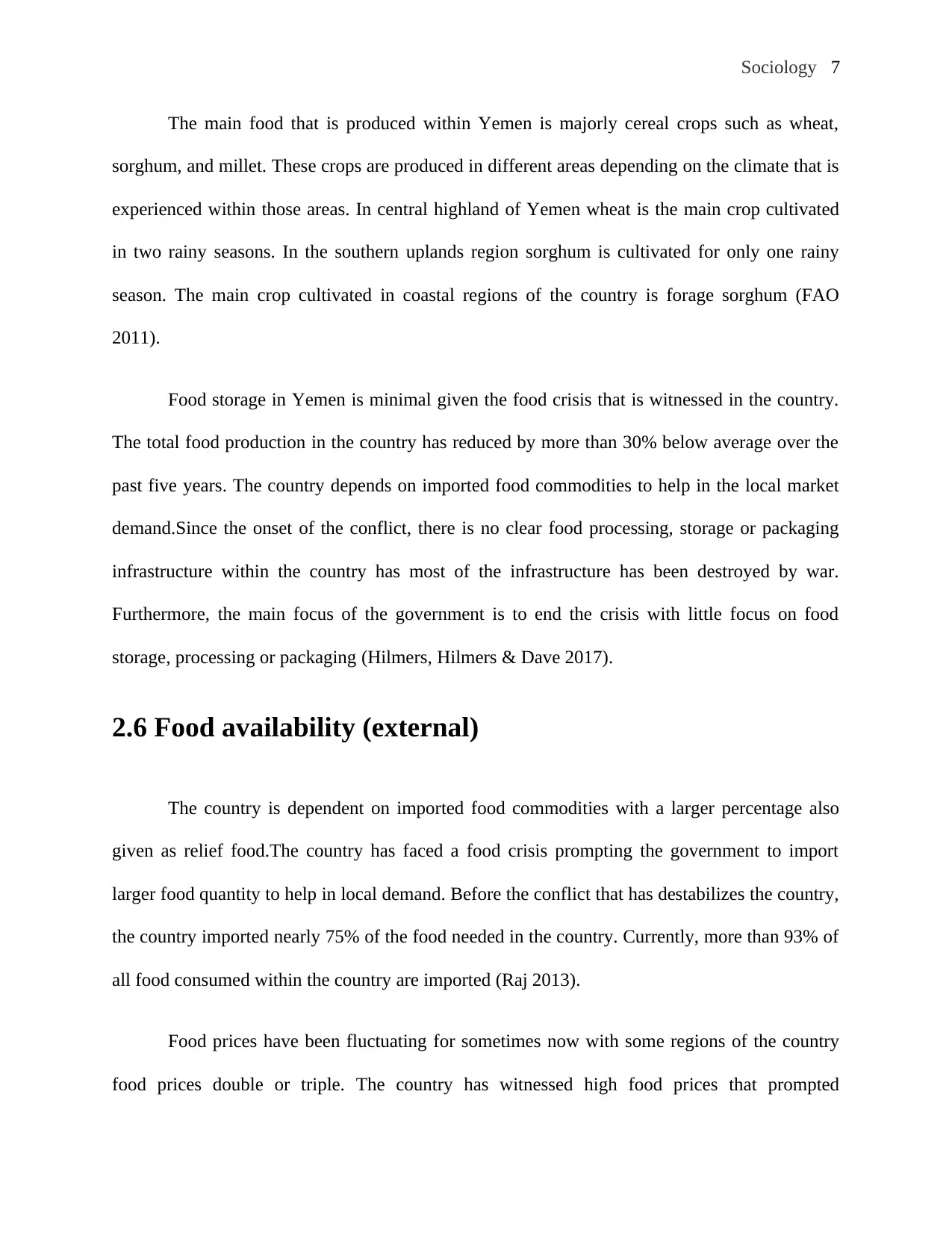
Sociology 7
The main food that is produced within Yemen is majorly cereal crops such as wheat,
sorghum, and millet. These crops are produced in different areas depending on the climate that is
experienced within those areas. In central highland of Yemen wheat is the main crop cultivated
in two rainy seasons. In the southern uplands region sorghum is cultivated for only one rainy
season. The main crop cultivated in coastal regions of the country is forage sorghum (FAO
2011).
Food storage in Yemen is minimal given the food crisis that is witnessed in the country.
The total food production in the country has reduced by more than 30% below average over the
past five years. The country depends on imported food commodities to help in the local market
demand.Since the onset of the conflict, there is no clear food processing, storage or packaging
infrastructure within the country has most of the infrastructure has been destroyed by war.
Furthermore, the main focus of the government is to end the crisis with little focus on food
storage, processing or packaging (Hilmers, Hilmers & Dave 2017).
2.6 Food availability (external)
The country is dependent on imported food commodities with a larger percentage also
given as relief food.The country has faced a food crisis prompting the government to import
larger food quantity to help in local demand. Before the conflict that has destabilizes the country,
the country imported nearly 75% of the food needed in the country. Currently, more than 93% of
all food consumed within the country are imported (Raj 2013).
Food prices have been fluctuating for sometimes now with some regions of the country
food prices double or triple. The country has witnessed high food prices that prompted
The main food that is produced within Yemen is majorly cereal crops such as wheat,
sorghum, and millet. These crops are produced in different areas depending on the climate that is
experienced within those areas. In central highland of Yemen wheat is the main crop cultivated
in two rainy seasons. In the southern uplands region sorghum is cultivated for only one rainy
season. The main crop cultivated in coastal regions of the country is forage sorghum (FAO
2011).
Food storage in Yemen is minimal given the food crisis that is witnessed in the country.
The total food production in the country has reduced by more than 30% below average over the
past five years. The country depends on imported food commodities to help in the local market
demand.Since the onset of the conflict, there is no clear food processing, storage or packaging
infrastructure within the country has most of the infrastructure has been destroyed by war.
Furthermore, the main focus of the government is to end the crisis with little focus on food
storage, processing or packaging (Hilmers, Hilmers & Dave 2017).
2.6 Food availability (external)
The country is dependent on imported food commodities with a larger percentage also
given as relief food.The country has faced a food crisis prompting the government to import
larger food quantity to help in local demand. Before the conflict that has destabilizes the country,
the country imported nearly 75% of the food needed in the country. Currently, more than 93% of
all food consumed within the country are imported (Raj 2013).
Food prices have been fluctuating for sometimes now with some regions of the country
food prices double or triple. The country has witnessed high food prices that prompted
Paraphrase This Document
Need a fresh take? Get an instant paraphrase of this document with our AI Paraphraser
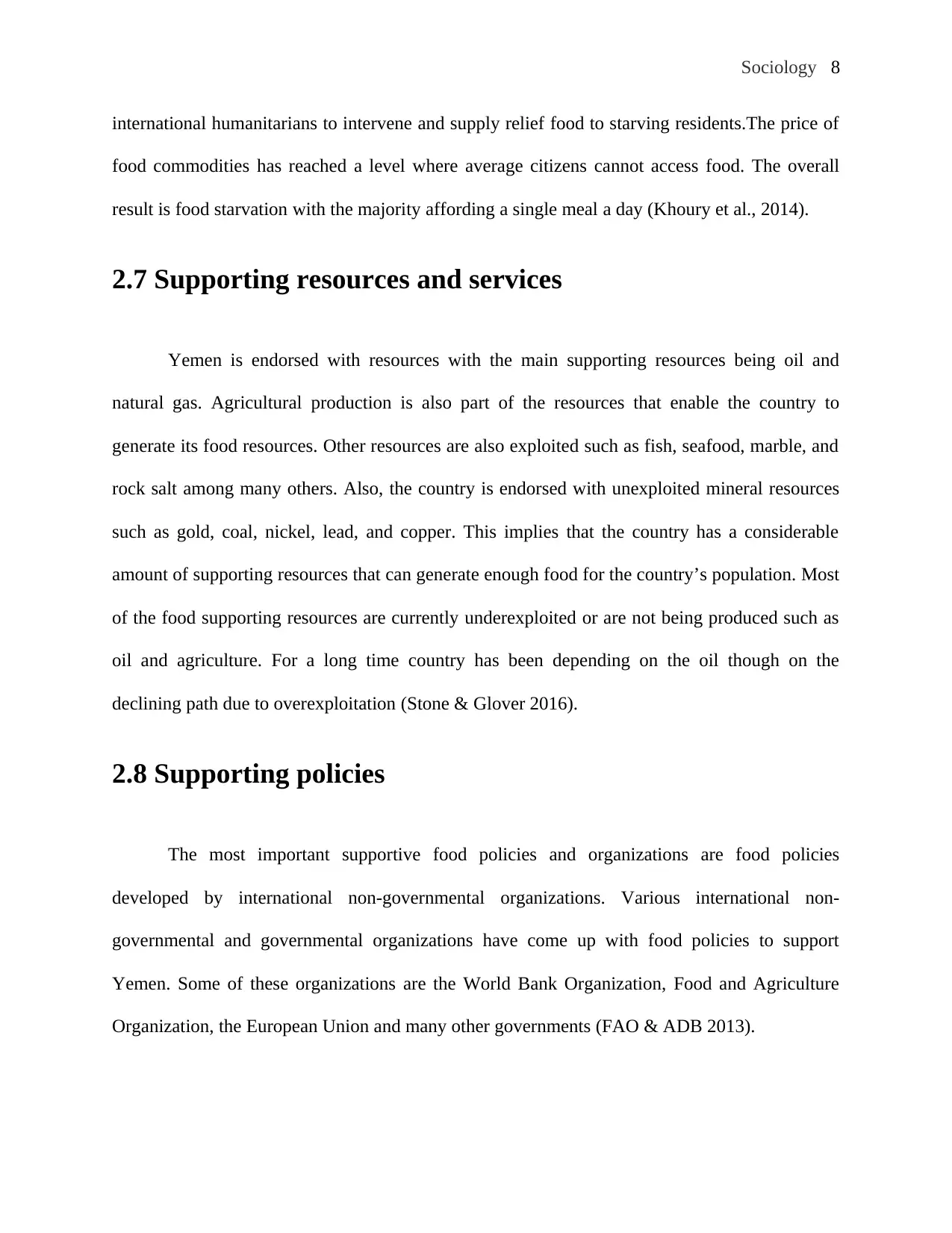
Sociology 8
international humanitarians to intervene and supply relief food to starving residents.The price of
food commodities has reached a level where average citizens cannot access food. The overall
result is food starvation with the majority affording a single meal a day (Khoury et al., 2014).
2.7 Supporting resources and services
Yemen is endorsed with resources with the main supporting resources being oil and
natural gas. Agricultural production is also part of the resources that enable the country to
generate its food resources. Other resources are also exploited such as fish, seafood, marble, and
rock salt among many others. Also, the country is endorsed with unexploited mineral resources
such as gold, coal, nickel, lead, and copper. This implies that the country has a considerable
amount of supporting resources that can generate enough food for the country’s population. Most
of the food supporting resources are currently underexploited or are not being produced such as
oil and agriculture. For a long time country has been depending on the oil though on the
declining path due to overexploitation (Stone & Glover 2016).
2.8 Supporting policies
The most important supportive food policies and organizations are food policies
developed by international non-governmental organizations. Various international non-
governmental and governmental organizations have come up with food policies to support
Yemen. Some of these organizations are the World Bank Organization, Food and Agriculture
Organization, the European Union and many other governments (FAO & ADB 2013).
international humanitarians to intervene and supply relief food to starving residents.The price of
food commodities has reached a level where average citizens cannot access food. The overall
result is food starvation with the majority affording a single meal a day (Khoury et al., 2014).
2.7 Supporting resources and services
Yemen is endorsed with resources with the main supporting resources being oil and
natural gas. Agricultural production is also part of the resources that enable the country to
generate its food resources. Other resources are also exploited such as fish, seafood, marble, and
rock salt among many others. Also, the country is endorsed with unexploited mineral resources
such as gold, coal, nickel, lead, and copper. This implies that the country has a considerable
amount of supporting resources that can generate enough food for the country’s population. Most
of the food supporting resources are currently underexploited or are not being produced such as
oil and agriculture. For a long time country has been depending on the oil though on the
declining path due to overexploitation (Stone & Glover 2016).
2.8 Supporting policies
The most important supportive food policies and organizations are food policies
developed by international non-governmental organizations. Various international non-
governmental and governmental organizations have come up with food policies to support
Yemen. Some of these organizations are the World Bank Organization, Food and Agriculture
Organization, the European Union and many other governments (FAO & ADB 2013).
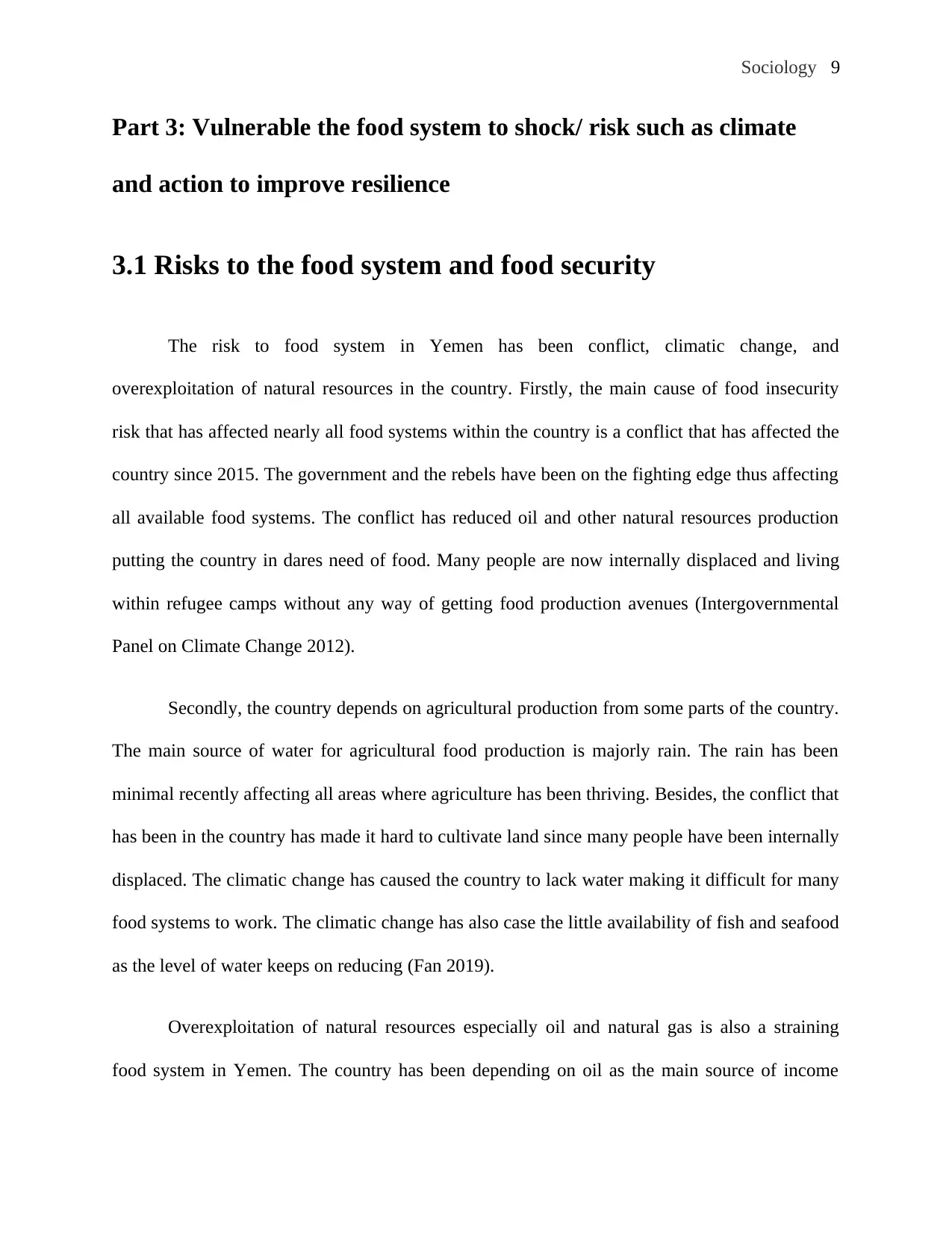
Sociology 9
Part 3: Vulnerable the food system to shock/ risk such as climate
and action to improve resilience
3.1 Risks to the food system and food security
The risk to food system in Yemen has been conflict, climatic change, and
overexploitation of natural resources in the country. Firstly, the main cause of food insecurity
risk that has affected nearly all food systems within the country is a conflict that has affected the
country since 2015. The government and the rebels have been on the fighting edge thus affecting
all available food systems. The conflict has reduced oil and other natural resources production
putting the country in dares need of food. Many people are now internally displaced and living
within refugee camps without any way of getting food production avenues (Intergovernmental
Panel on Climate Change 2012).
Secondly, the country depends on agricultural production from some parts of the country.
The main source of water for agricultural food production is majorly rain. The rain has been
minimal recently affecting all areas where agriculture has been thriving. Besides, the conflict that
has been in the country has made it hard to cultivate land since many people have been internally
displaced. The climatic change has caused the country to lack water making it difficult for many
food systems to work. The climatic change has also case the little availability of fish and seafood
as the level of water keeps on reducing (Fan 2019).
Overexploitation of natural resources especially oil and natural gas is also a straining
food system in Yemen. The country has been depending on oil as the main source of income
Part 3: Vulnerable the food system to shock/ risk such as climate
and action to improve resilience
3.1 Risks to the food system and food security
The risk to food system in Yemen has been conflict, climatic change, and
overexploitation of natural resources in the country. Firstly, the main cause of food insecurity
risk that has affected nearly all food systems within the country is a conflict that has affected the
country since 2015. The government and the rebels have been on the fighting edge thus affecting
all available food systems. The conflict has reduced oil and other natural resources production
putting the country in dares need of food. Many people are now internally displaced and living
within refugee camps without any way of getting food production avenues (Intergovernmental
Panel on Climate Change 2012).
Secondly, the country depends on agricultural production from some parts of the country.
The main source of water for agricultural food production is majorly rain. The rain has been
minimal recently affecting all areas where agriculture has been thriving. Besides, the conflict that
has been in the country has made it hard to cultivate land since many people have been internally
displaced. The climatic change has caused the country to lack water making it difficult for many
food systems to work. The climatic change has also case the little availability of fish and seafood
as the level of water keeps on reducing (Fan 2019).
Overexploitation of natural resources especially oil and natural gas is also a straining
food system in Yemen. The country has been depending on oil as the main source of income
⊘ This is a preview!⊘
Do you want full access?
Subscribe today to unlock all pages.

Trusted by 1+ million students worldwide
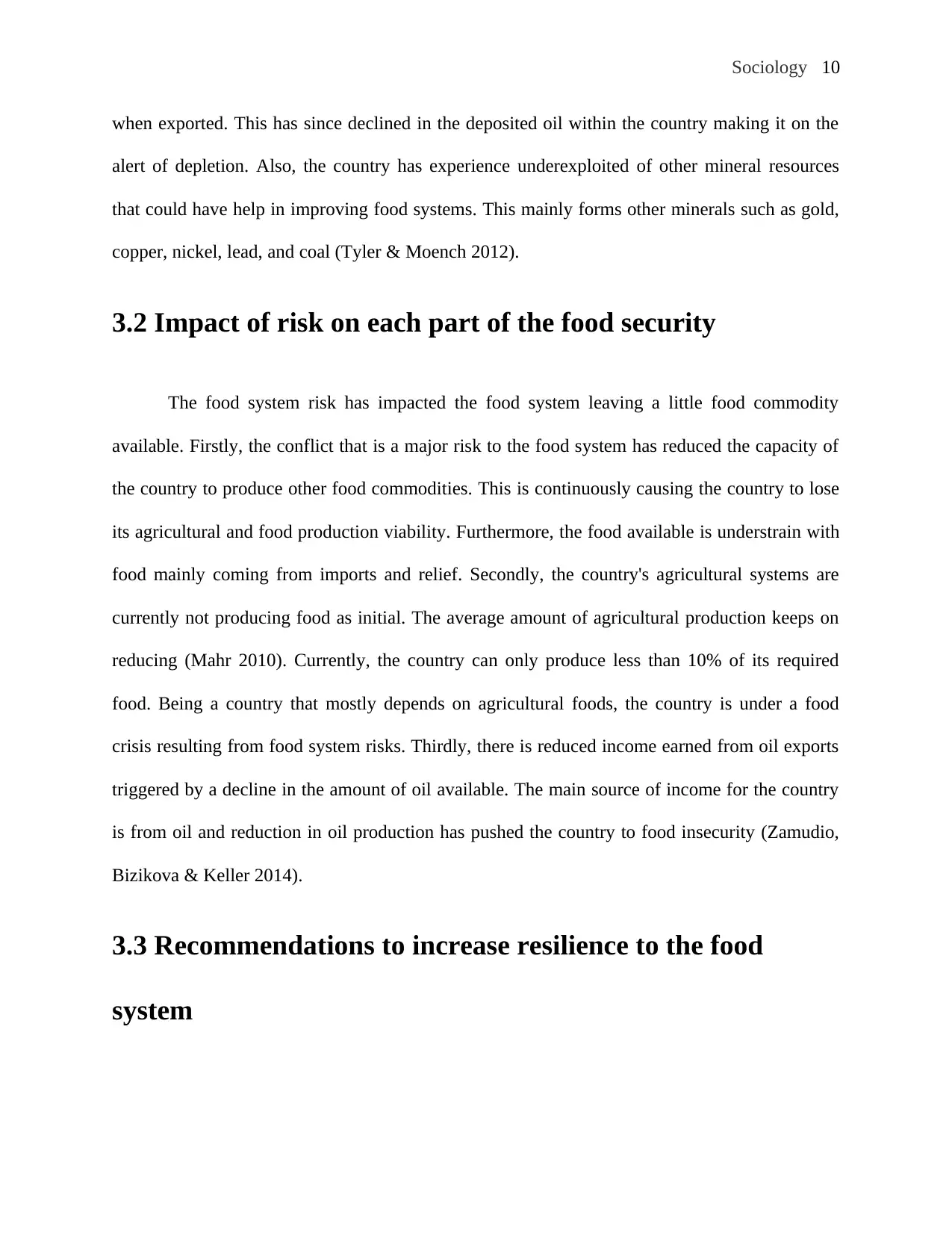
Sociology 10
when exported. This has since declined in the deposited oil within the country making it on the
alert of depletion. Also, the country has experience underexploited of other mineral resources
that could have help in improving food systems. This mainly forms other minerals such as gold,
copper, nickel, lead, and coal (Tyler & Moench 2012).
3.2 Impact of risk on each part of the food security
The food system risk has impacted the food system leaving a little food commodity
available. Firstly, the conflict that is a major risk to the food system has reduced the capacity of
the country to produce other food commodities. This is continuously causing the country to lose
its agricultural and food production viability. Furthermore, the food available is understrain with
food mainly coming from imports and relief. Secondly, the country's agricultural systems are
currently not producing food as initial. The average amount of agricultural production keeps on
reducing (Mahr 2010). Currently, the country can only produce less than 10% of its required
food. Being a country that mostly depends on agricultural foods, the country is under a food
crisis resulting from food system risks. Thirdly, there is reduced income earned from oil exports
triggered by a decline in the amount of oil available. The main source of income for the country
is from oil and reduction in oil production has pushed the country to food insecurity (Zamudio,
Bizikova & Keller 2014).
3.3 Recommendations to increase resilience to the food
system
when exported. This has since declined in the deposited oil within the country making it on the
alert of depletion. Also, the country has experience underexploited of other mineral resources
that could have help in improving food systems. This mainly forms other minerals such as gold,
copper, nickel, lead, and coal (Tyler & Moench 2012).
3.2 Impact of risk on each part of the food security
The food system risk has impacted the food system leaving a little food commodity
available. Firstly, the conflict that is a major risk to the food system has reduced the capacity of
the country to produce other food commodities. This is continuously causing the country to lose
its agricultural and food production viability. Furthermore, the food available is understrain with
food mainly coming from imports and relief. Secondly, the country's agricultural systems are
currently not producing food as initial. The average amount of agricultural production keeps on
reducing (Mahr 2010). Currently, the country can only produce less than 10% of its required
food. Being a country that mostly depends on agricultural foods, the country is under a food
crisis resulting from food system risks. Thirdly, there is reduced income earned from oil exports
triggered by a decline in the amount of oil available. The main source of income for the country
is from oil and reduction in oil production has pushed the country to food insecurity (Zamudio,
Bizikova & Keller 2014).
3.3 Recommendations to increase resilience to the food
system
Paraphrase This Document
Need a fresh take? Get an instant paraphrase of this document with our AI Paraphraser
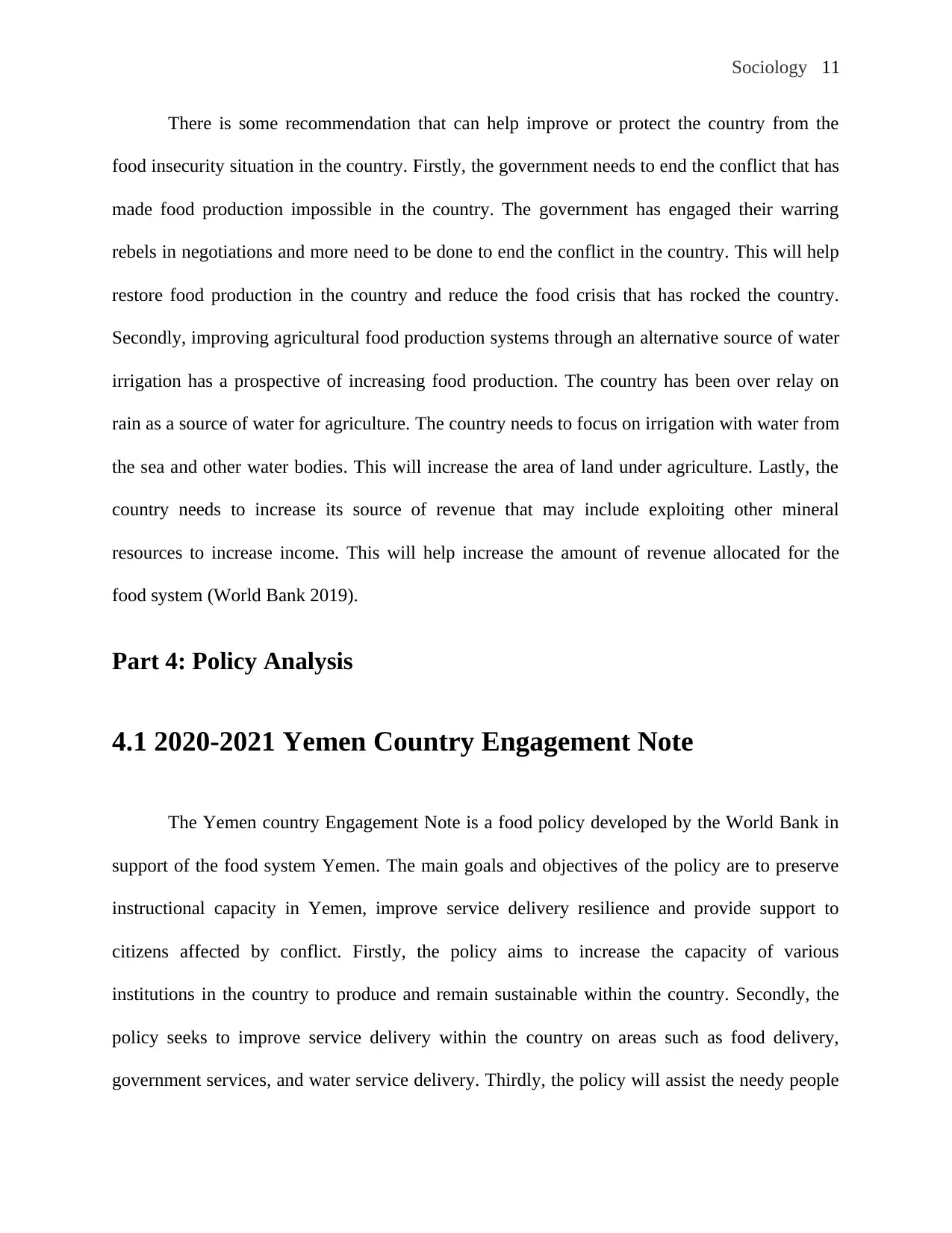
Sociology 11
There is some recommendation that can help improve or protect the country from the
food insecurity situation in the country. Firstly, the government needs to end the conflict that has
made food production impossible in the country. The government has engaged their warring
rebels in negotiations and more need to be done to end the conflict in the country. This will help
restore food production in the country and reduce the food crisis that has rocked the country.
Secondly, improving agricultural food production systems through an alternative source of water
irrigation has a prospective of increasing food production. The country has been over relay on
rain as a source of water for agriculture. The country needs to focus on irrigation with water from
the sea and other water bodies. This will increase the area of land under agriculture. Lastly, the
country needs to increase its source of revenue that may include exploiting other mineral
resources to increase income. This will help increase the amount of revenue allocated for the
food system (World Bank 2019).
Part 4: Policy Analysis
4.1 2020-2021 Yemen Country Engagement Note
The Yemen country Engagement Note is a food policy developed by the World Bank in
support of the food system Yemen. The main goals and objectives of the policy are to preserve
instructional capacity in Yemen, improve service delivery resilience and provide support to
citizens affected by conflict. Firstly, the policy aims to increase the capacity of various
institutions in the country to produce and remain sustainable within the country. Secondly, the
policy seeks to improve service delivery within the country on areas such as food delivery,
government services, and water service delivery. Thirdly, the policy will assist the needy people
There is some recommendation that can help improve or protect the country from the
food insecurity situation in the country. Firstly, the government needs to end the conflict that has
made food production impossible in the country. The government has engaged their warring
rebels in negotiations and more need to be done to end the conflict in the country. This will help
restore food production in the country and reduce the food crisis that has rocked the country.
Secondly, improving agricultural food production systems through an alternative source of water
irrigation has a prospective of increasing food production. The country has been over relay on
rain as a source of water for agriculture. The country needs to focus on irrigation with water from
the sea and other water bodies. This will increase the area of land under agriculture. Lastly, the
country needs to increase its source of revenue that may include exploiting other mineral
resources to increase income. This will help increase the amount of revenue allocated for the
food system (World Bank 2019).
Part 4: Policy Analysis
4.1 2020-2021 Yemen Country Engagement Note
The Yemen country Engagement Note is a food policy developed by the World Bank in
support of the food system Yemen. The main goals and objectives of the policy are to preserve
instructional capacity in Yemen, improve service delivery resilience and provide support to
citizens affected by conflict. Firstly, the policy aims to increase the capacity of various
institutions in the country to produce and remain sustainable within the country. Secondly, the
policy seeks to improve service delivery within the country on areas such as food delivery,
government services, and water service delivery. Thirdly, the policy will assist the needy people
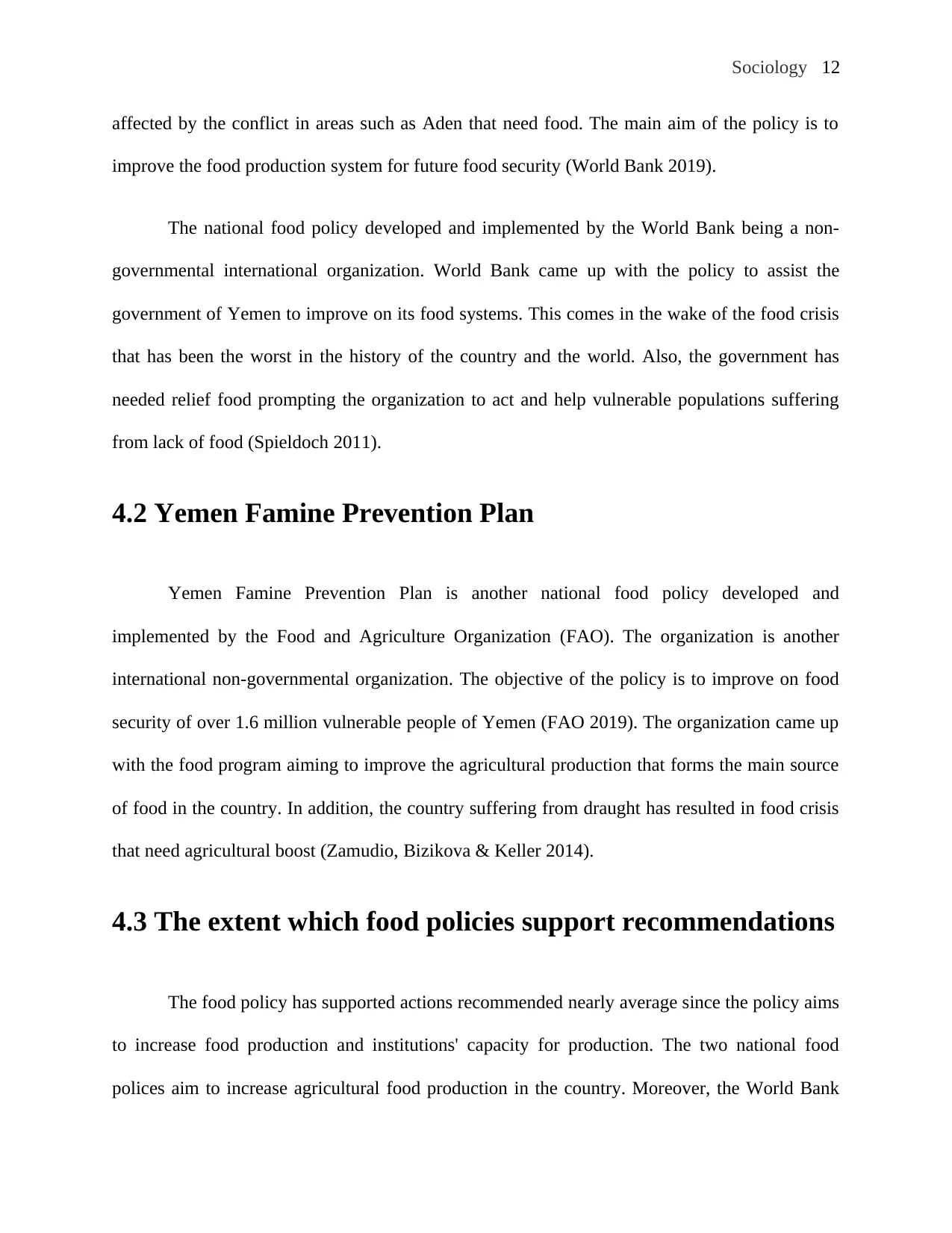
Sociology 12
affected by the conflict in areas such as Aden that need food. The main aim of the policy is to
improve the food production system for future food security (World Bank 2019).
The national food policy developed and implemented by the World Bank being a non-
governmental international organization. World Bank came up with the policy to assist the
government of Yemen to improve on its food systems. This comes in the wake of the food crisis
that has been the worst in the history of the country and the world. Also, the government has
needed relief food prompting the organization to act and help vulnerable populations suffering
from lack of food (Spieldoch 2011).
4.2 Yemen Famine Prevention Plan
Yemen Famine Prevention Plan is another national food policy developed and
implemented by the Food and Agriculture Organization (FAO). The organization is another
international non-governmental organization. The objective of the policy is to improve on food
security of over 1.6 million vulnerable people of Yemen (FAO 2019). The organization came up
with the food program aiming to improve the agricultural production that forms the main source
of food in the country. In addition, the country suffering from draught has resulted in food crisis
that need agricultural boost (Zamudio, Bizikova & Keller 2014).
4.3 The extent which food policies support recommendations
The food policy has supported actions recommended nearly average since the policy aims
to increase food production and institutions' capacity for production. The two national food
polices aim to increase agricultural food production in the country. Moreover, the World Bank
affected by the conflict in areas such as Aden that need food. The main aim of the policy is to
improve the food production system for future food security (World Bank 2019).
The national food policy developed and implemented by the World Bank being a non-
governmental international organization. World Bank came up with the policy to assist the
government of Yemen to improve on its food systems. This comes in the wake of the food crisis
that has been the worst in the history of the country and the world. Also, the government has
needed relief food prompting the organization to act and help vulnerable populations suffering
from lack of food (Spieldoch 2011).
4.2 Yemen Famine Prevention Plan
Yemen Famine Prevention Plan is another national food policy developed and
implemented by the Food and Agriculture Organization (FAO). The organization is another
international non-governmental organization. The objective of the policy is to improve on food
security of over 1.6 million vulnerable people of Yemen (FAO 2019). The organization came up
with the food program aiming to improve the agricultural production that forms the main source
of food in the country. In addition, the country suffering from draught has resulted in food crisis
that need agricultural boost (Zamudio, Bizikova & Keller 2014).
4.3 The extent which food policies support recommendations
The food policy has supported actions recommended nearly average since the policy aims
to increase food production and institutions' capacity for production. The two national food
polices aim to increase agricultural food production in the country. Moreover, the World Bank
⊘ This is a preview!⊘
Do you want full access?
Subscribe today to unlock all pages.

Trusted by 1+ million students worldwide
1 out of 17
Related Documents
Your All-in-One AI-Powered Toolkit for Academic Success.
+13062052269
info@desklib.com
Available 24*7 on WhatsApp / Email
![[object Object]](/_next/static/media/star-bottom.7253800d.svg)
Unlock your academic potential
Copyright © 2020–2025 A2Z Services. All Rights Reserved. Developed and managed by ZUCOL.





